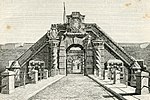Anapo
Drainage basins of the Ionian SeaRivers of ItalyRivers of SicilyRivers of the Province of Syracuse

The Anapo (Sicilian: Ànapu) is a river in Sicily whose ancient Greek name is similar to the word for "swallowed up" and at many points on its course it runs underground. The Greek myth of Anapos is associated with it. The river springs from the Monte Lauro in the Hyblaean Mountains (hills), on the territory of Buscemi, crossing the whole territory of Syracuse, where it flows into the Ionian Sea together with the Ciane. Historically, its waters were used to feed the aqueduct of Syracuse, built in 480 BC by the tyrant Gelo and running for 22 kilometres (14 mi). Its waters now power the hydroelectrical station near Solarino.
Excerpt from the Wikipedia article Anapo (License: CC BY-SA 3.0, Authors, Images).Anapo
Via Elorina, Syracuse
Geographical coordinates (GPS) Address Nearby Places Show on map
Geographical coordinates (GPS)
| Latitude | Longitude |
|---|---|
| N 37.0552 ° | E 15.2703 ° |
Address
Circolo nautico Ciane
Via Elorina
96100 Syracuse
Sicily, Italy
Open on Google Maps











